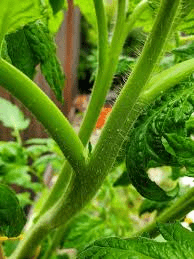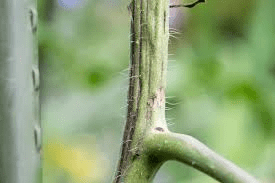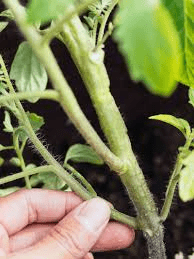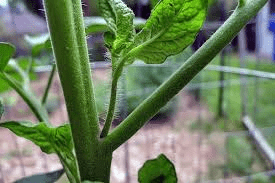Tomato stems are a fundamental part of the tomato plant, providing structural support and playing vital roles in nutrient transport and overall plant health. They are typically green, cylindrical, and covered with tiny hair-like structures called trichomes, which help protect the plant from pests and reduce water loss.
Economically, tomato stems are significant in tomato cultivation as they support the plant’s growth and fruit production. Healthy stems are essential for sustaining the weight of the plant and its fruit, which is crucial for achieving high yields.
Farmers often use stakes, cages, or trellises to support the stems, ensuring that the plant can grow vertically and maximize space and sunlight exposure. This practice also helps in reducing diseases by keeping the foliage and fruit off the ground.
In terms of uses, while the stems themselves are not typically consumed, they have several practical applications. For instance, they can be composted to create organic fertilizer, enriching the soil and promoting sustainable agricultural practices.
The fibrous nature of tomato stems also makes them suitable for use in bio-based materials and products, such as biodegradable plant pots or mulches, contributing to eco-friendly gardening and farming.
Scientifically, tomato stems are of interest for their role in plant physiology and genetics. Researchers study the stem’s vascular system, which includes the xylem and phloem, to understand how water, nutrients, and sugars are transported throughout the plant.
This knowledge can lead to advances in crop breeding, aimed at developing tomato varieties with improved resistance to environmental stressors and diseases. Additionally, the study of trichomes on tomato stems provides insights into natural pest resistance mechanisms, which can inform the development of sustainable pest management strategies.
Tomato stems are a crucial component of the tomato plant, supporting its growth, fruit production, and overall health. Their economic importance is evident in agricultural practices aimed at maximizing yield and quality, while their potential uses in composting and bio-based products highlight their role in sustainable agriculture. Scientifically, understanding the functions and properties of tomato stems contributes to advances in crop breeding and pest management, ultimately enhancing tomato cultivation and production.
The Economic Importance and Uses of Tomato Stems

1. Biofuel Production: Tomato stems can be converted into biofuels such as bioethanol through fermentation processes. This provides an alternative energy source and helps reduce dependence on fossil fuels.
2. Composting: Tomato stems are a valuable component of compost. They add organic matter and nutrients to compost piles, enriching the soil and improving plant growth.
3. Mulching: Dried tomato stems can be used as mulch to retain soil moisture, suppress weeds, and regulate soil temperature, enhancing crop yields.
4. Animal Feed: Tomato stems, when processed, can be used as a supplementary feed for livestock, providing fiber and nutrients.
5. Biodegradable Products: The fibers from tomato stems can be used to manufacture biodegradable products such as packaging materials and disposable utensils, reducing plastic waste.
6. Paper Production: Tomato stem fibers are suitable for making paper and cardboard, offering an eco-friendly alternative to traditional wood-based paper.
7. Textiles: The cellulose fibers in tomato stems can be processed into textile materials, contributing to sustainable fashion and reducing the environmental impact of traditional textiles.
8. Biochar Production: Tomato stems can be converted into biochar, a type of charcoal used to improve soil health and sequester carbon, mitigating climate change.
9. Extraction of Bioactive Compounds: Tomato stems contain bioactive compounds such as flavonoids and phenolics, which can be extracted and used in pharmaceuticals, cosmetics, and nutraceuticals.
10. Phytoremediation: Tomato plants, including their stems, can be used in phytoremediation to absorb and remove contaminants from soil and water, helping clean up polluted environments.
11. Garden Stakes: Tomato stems can be dried and used as natural stakes for supporting other plants in the garden, providing a sustainable alternative to plastic or metal stakes.
12. Craft Materials: Dried tomato stems can be used in crafting and DIY projects, such as making wreaths, decorations, and plant supports.
13. Natural Dyes: Extracts from tomato stems can be used to create natural dyes for textiles and other materials, offering a sustainable alternative to synthetic dyes.
14. Bioplastics: The cellulose in tomato stems can be used to produce bioplastics, which are biodegradable and reduce reliance on petroleum-based plastics.
15. Soil Conditioner: Ground tomato stems can be added to soil as a conditioner, improving soil structure, aeration, and fertility.
16. Enzymatic Hydrolysis: Tomato stems can undergo enzymatic hydrolysis to produce sugars, which can then be used in various industrial processes, including fermentation and biofuel production.
17. Mushroom Cultivation: Tomato stems provide a good substrate for cultivating mushrooms, offering an additional revenue stream for farmers.
18. Research and Development: Tomato stems are used in research to study plant physiology, pest resistance, and sustainable agricultural practices, contributing to scientific advancements and agricultural innovations.
Read Also: Burmese Cat Breed (Felis catus) Description and Complete Care Guide
The Products and By-products That Can Be Derived From Tomato Stems

1. Bioethanol: Produced through the fermentation of tomato stems, bioethanol serves as a renewable energy source for transportation and industrial applications.
2. Compost: Tomato stems are composted to create nutrient-rich compost, which is used to improve soil health and promote plant growth.
3. Mulch: Dried tomato stems are used as mulch to retain soil moisture, suppress weeds, and protect plants from temperature fluctuations.
4. Livestock Feed: Processed tomato stems are added to livestock feed to provide additional fiber and nutrients, improving animal health and productivity.
5. Biodegradable Packaging: Tomato stem fibers are used to manufacture biodegradable packaging materials, reducing environmental pollution.
6. Paper and Cardboard: The cellulose fibers in tomato stems are processed into paper and cardboard products, offering a sustainable alternative to wood-based products.
7. Textile Fibers: Tomato stem fibers are used in the production of eco-friendly textiles, contributing to sustainable fashion.
8. Biochar: Tomato stems are converted into biochar, which is used to improve soil fertility and sequester carbon, helping mitigate climate change.
9. Bioactive Extracts: Bioactive compounds extracted from tomato stems are used in the pharmaceutical, cosmetic, and nutraceutical industries for their health benefits.
10. Phytoremediation Substrates: Tomato stems are used in phytoremediation projects to absorb and remove contaminants from soil and water.
11. Garden Stakes: Dried tomato stems are used as natural stakes for supporting plants, providing a sustainable gardening solution.
12. Craft Products: Tomato stems are used in crafting to create wreaths, decorations, and other DIY projects.
13. Natural Dyes: Extracts from tomato stems are used to produce natural dyes for textiles and other materials, offering an eco-friendly alternative to synthetic dyes.
14. Bioplastics: The cellulose in tomato stems is used to produce bioplastics, which are biodegradable and reduce reliance on petroleum-based plastics.
15. Soil Conditioner: Ground tomato stems are used as a soil conditioner to improve soil structure, aeration, and fertility.
16. Sugars for Fermentation: Enzymatic hydrolysis of tomato stems produces sugars that are used in fermentation processes for biofuel and other industrial applications.
17. Mushroom Substrate: Tomato stems provide a suitable substrate for mushroom cultivation, offering an additional revenue stream for farmers.
Read Also: Himalayan Cats (Felis catus) Description and Complete Care Guide
Frequently Asked Questions (FAQ’s) About Tomato Stems

1. What are tomato stems?
Tomato stems are the supportive structures of the tomato plant, bearing the leaves, flowers, and fruits.
2. Can tomato stems be used as biofuel?
Yes, tomato stems can be converted into bioethanol through fermentation, providing a renewable energy source.
3. Are tomato stems good for composting?
Yes, tomato stems add organic matter and nutrients to compost, enriching the soil and promoting plant growth.
4. How can tomato stems be used in animal feed?
Processed tomato stems can be added to livestock feed to provide additional fiber and nutrients.
5. Can tomato stems be used to make biodegradable products?
Yes, the fibers from tomato stems can be used to manufacture biodegradable packaging, utensils, and other products.
6. How are tomato stems used in paper production?
Tomato stem fibers are processed to make paper and cardboard, offering a sustainable alternative to wood-based paper.
7. Can tomato stems be used in textiles?
Yes, the cellulose fibers in tomato stems can be processed into textile materials for sustainable fashion.
8. What is biochar, and how is it made from tomato stems?
Biochar is a type of charcoal made from organic materials like tomato stems, used to improve soil health and sequester carbon.
9. Are there bioactive compounds in tomato stems?
Yes, tomato stems contain bioactive compounds such as flavonoids and phenolics, which have health benefits.
10. How are tomato stems used in phytoremediation?
Tomato plants, including their stems, can absorb and remove contaminants from soil and water, helping clean up polluted environments.
Read Also: Comminutor and Grinder Process

